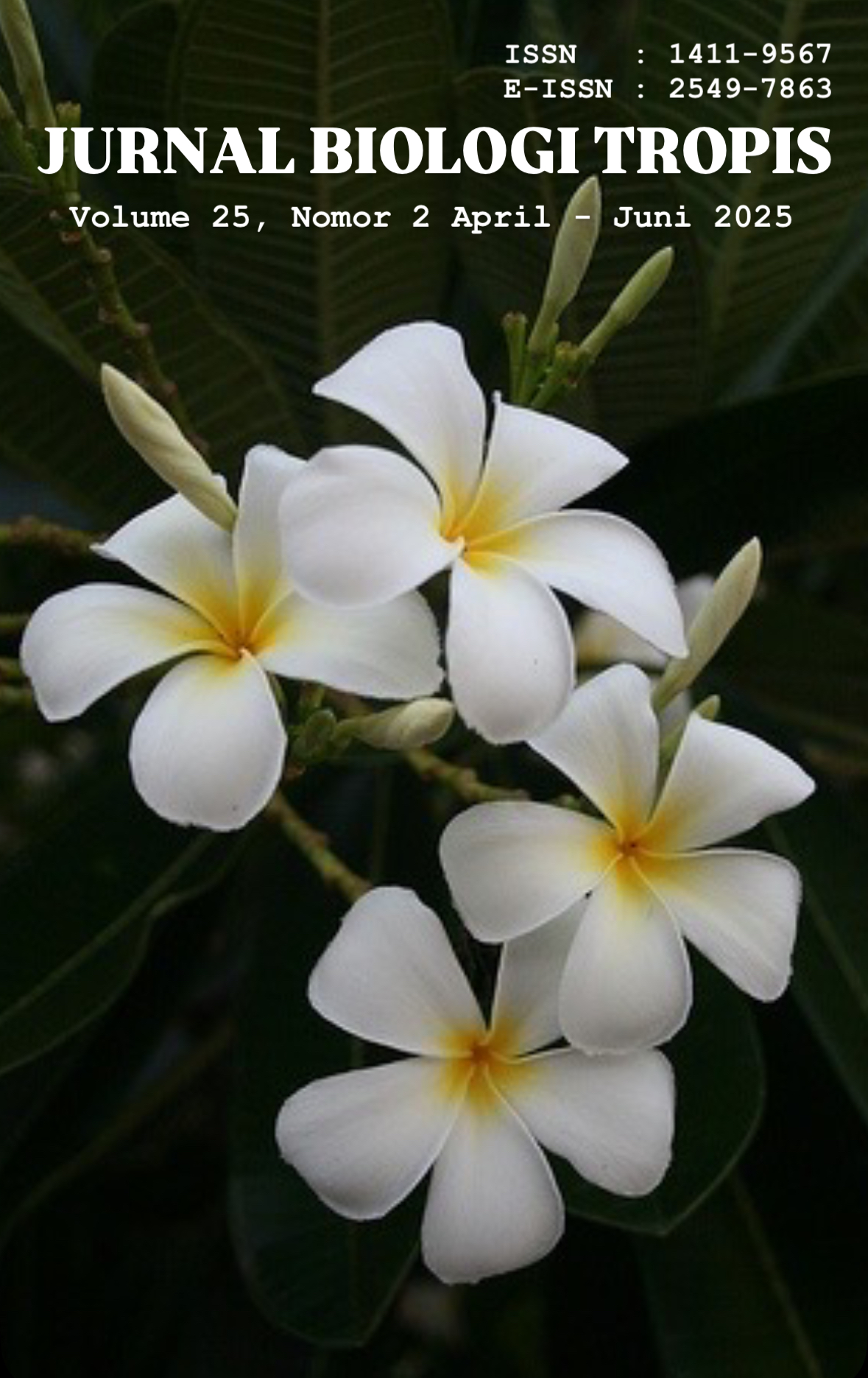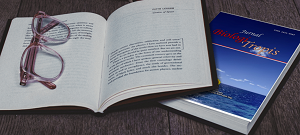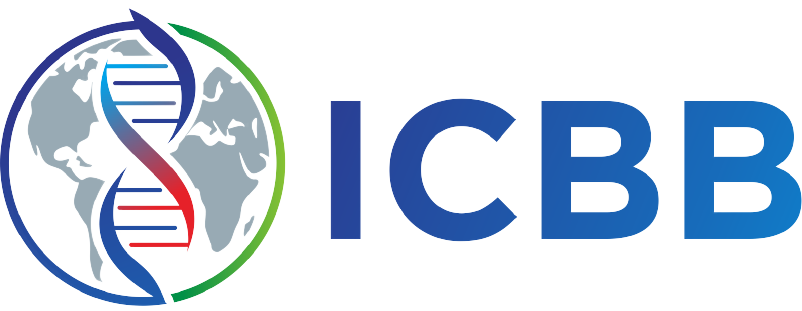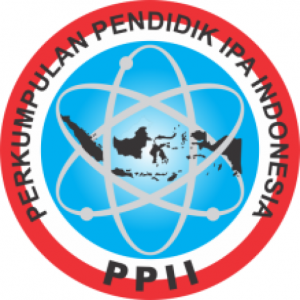Potential of Trichoderma harzianum as Environmentally Friendly Natural Pesticides for Controlling Phytophthora in Duku Plants
Authors
Triyuni Verza Abdilla , Edenia Septefine Simamora , Zahra Dini Amelia , Putri Dwi MulyaniDOI:
10.29303/jbt.v25i2.8611Published:
2025-04-30Issue:
Vol. 25 No. 2 (2025): April-JuniKeywords:
Duku, kanker batang, Phytophthora sp., Trichoderma.Articles
Downloads
How to Cite
Downloads
Metrics
Abstract
Duku fruit production in Jambi has begun to decline, one of the causes is stem cancer. This stem cancer disease is caused by the fungus Phytophthora sp. The symptoms caused by this disease are dry and soft bark like cork, wilted leaves and falling off until the tree finally dies. The purpose of this study was to isolate Phytophthora sp., characterize the morphology of the pathogen and test the ability of Trichoderma to inhibit the growth of Phytophthora sp. The research was conducted by calculating the percentage of inhibition starting from sampling the organs of the duku plant and continuing to the isolation stage. The antagonistic test of Phytophthora sp. against Trichoderma was carried out using the dual culture method (dual culture). The results showed that Phytophthora sp. can be obtained from the bark of plants, with characteristics of colonies that are textured like cotton, white in color, round in shape with uneven edges. Microscopic observation of fungal isolates showed that Phytophthora sp. has morphological characteristics in the form of round-oval conidia, non-septate mycelium and branched conidiophores. Trichoderma has the ability to inhibit the growth of Phytophthora sp. with an inhibitory power of 63.52%.
References
Afriati, N., Parawansa, A. K., & Haris, A. (2022). Isolasi Dan Morfologi Cendawan Phytopthora Palmivora Butl Pada Batang Kakao (Theobromae cacao L). AGrotekMAS Jurnal Indonesia: Jurnal Ilmu Peranian, 2(2), 16–22. https://doi.org/10.33096/agrotekmas.v2i2.187
Ainy, E. Q., Ratnayani, R., & Susilawati, L. (2015). Uji Aktivitas Antagonis Trichoderma Harzianum 11035 Terhadap Colletotrichum capsici TCKR2 dan Colletotrichum acutatum TCK1 Penyebab Antraknosa pada Tanaman Cabai. Prosiding Seminar Nasional XII Pendidikan Biologi FKIP UNS. Surakarta, 8 Agustus 2017., 892–897.
Amalia, N. A., & Elviantari, A. (2023). Eksplorasi Dan Isolasi Trichoderma Spp. Pada Rizosfer Kopi Robusta dibeberapa Kecamatan Sumbawa. Biomaras, 1(1), 13–20.
Armila, Z., Ambar, A. A., Ilmi, N., Harsani, & Rahim, I. (2019). Potensi Jamur Trichoderma sp. Dalam Pengendalian Phytopthora palmivora Secara In Vitro. Prosiding Seminar Nasional 2019, 2, 26–27.
Cikita, D., Khotimah, S., & Linda, R. (2016). Uji antagonis Trichoderma spp. terhadap Phytophthora palmivora Butl. penyebab penyakit busuk buah Kakao (Theobroma cacao L.). Jurnal Protobiont, 5(3), 59–65. http://jurnal.untan.ac.id/index.php/jprb/article/download/17016/14560
Dewi, A. L., Oktavianingsih, L., & Sudrajat. (2015). Identifikasi Cendawan Mikroskopis yang Berasosiasi dengan Penyakit Busuk Pangkal Batang Tanaman Lada ( Piper nigrum L .) di Desa Batuah Kecamatan Loa Janan Kutai Kartanegara. Prosiding Seminar Tugas Akhir FMIPA UNMUL 2015, 12(4), 132–142.
Dhaifulloh, A. D., Khayumi, B. I., Legawa, D. T., Muhammad, K. A. A., & Radianto, D. O. (2024). Dampak Penggunaan Pestisida Kimia Terhadap Kualitas Tanah dan Air Sungai di Daerah Pertanian. Jurnal Publikasi Rumpun Teknik, 2(2), 3031–5026. https://doi.org/10.61132/venus.v2i2.280
Halwiyah, N., Ferniah, R. S. F., Raharjo, B., & Purwantisari, S. (2019). Uji Antagonisme Jamur Patogen Fusarium solani Penyebab Penyakit Layu pada Tanaman Cabai dengan Menggunakan Beauveria bassiana Secara In Vitro. Jurnal Akademika Biologi, 8(2), 8–17.
Handoko, S., Hadisutrisno, B., Wibobo, A., & Widada, J. (2013). Peranan Unsur Cuaca Terhadap Perkembangan Penyakit Kanker Batang Duku Di Jambi. Jurnal Budidaya Pertanian, 9(2), 64–71.
Hayati, I., & Wiyono, S. (2019). Kepadatan Penyakit Phytophthora palmivora Botol Akar Bibit Duku ( Lansium domesticum ).
Khairul, I., Montong, V. B., & Ratulangi, M. M. (2018). Uji Antagonisme Trichoderma sp. terhadap Colletotrichum capsici Penyebab Penyakit Antraknosa pada Cabai Kering Secara In Vitro. Cocos, 1(2), 1–8.
Komalasari, I., Suryanti, S., & Hadisutrisno, B. (2018). Identification of the Causal Agent of Cocoa Pod Rot Disease from Various Locations. Jurnal Perlindungan Tanaman Indonesia, 22(1), 13. https://doi.org/10.22146/jpti.24728
Lizawati, Budiyathi Ichwan, Gusniwati, Neliyati1, M. Z. (2013). Fenologi Pertumbuhan Vegetatif Dan Generatif Tanaman Duku Varietas Kumpeh Pada Berbagai Umur. 2(1), 16–26.
Mukarlina, Khotimah, S., & Rianti, R. (2013). Uji Antagonis Trichoderma harzianum terhadap Fusarium spp. Penyebab Penyakit Layu pada Tanaman Cabai (Capsicum annum) secara in Vitro. Jurnal Fitomedika, 7(2), 80–85.
Muzuni, Haidin dan N.A.Yanti. 2020. Karakterisasi Morfologi Phytophthora sp. Asal Buah Kakao Desa Olo-oloho, Kabupaten Konawe, Sulawesi Tenggara. BioWallacea : Jurnal Penelitian Bioloogi. Vol 7 (1) : 1064-1069.
Nurfianti, & Umrah. (2019). Pengamatan Gejala Infeksi Phytophthora palmivora Penyebab Penyakit Busuk Buah Pada Kakao. Biocelebes, 13(3), 253–261. https://doi.org/10.22487/bioceb.v13i3.14969
Pehino, A., Fatimawali, F., & Suoth, E. J. (2021). Uji Aktivitas Antibakteri Ekstrak Biji Buah Duku Lansium domesticum Terhadap Bakteri Staphylococus aureus Dan Escherichia coli. Pharmacon, 10(2), 818.https://doi.org/10.35799/pha.10.2021.34030
Purwantisari, S.-, & Hastuti, R. B. (2012). Isolasi dan Identifikasi Jamur Indigenous Rhizosfer Tanaman Kentang dari Lahan Pertanian Kentang Organik di Desa Pakis, Magelang. Bioma : Berkala Ilmiah Biologi, 11(2),45.https://doi.org/10.14710/bioma.11.2.45-53
Purwantisari, S., RS, F., & B, dan R. (2008). Pengendalian Hayati Penyakit Lodoh (Busuk Umbi Kentang) dengan Agens Hayati Jamur-jamur Antagonis Isolat Lokal. Bioma, 10(2), 13–19.
Rahma, A. A., Zakariyya, F., & Aldini, G. M. (2022). Aplikasi Trichoderma sp. Terhadap Serangan Phytophthora palmivora Pada Media Tanam Campuran Kulit Buah Kakao Kering Untuk Pembibitan Kakao. National Multidisciplinary Sciences, 1(2), 194–203. https://doi.org/10.32528/nms.v1i2.55
Rahmawati, D., Yanuarsih, N., & Hastuti, U. S. (2018). Kajian Daya Antagonisme Kapang Trichoderma spp. terhadap Colletotrichum capsici dan Erysiphe cichoracearum Secara In Vitro. Proceeding Biology Education Conference, 15(1), 848–852.
Santoso, P. J. (2015). Karakteristik Empat Cendawan Patogen pada Durian : Phytophthora palmivora. Balai Penelitian Tanaman Buah Tropika, 59–64.
Sastrahidayat, I. R. 2017. Penyakit Tumbuhan yang Disebabkan oleh Jamur. Universitas Brawijaya Press, Malang.
Sundari, A., Khotimah, S., & Linda, R. (2014). Daya Antagonis Jamur Trichoderma sp. Terhadap Jamur Diplodia sp. Penyebab Busuk Batang Jeruk Siam (Citrus nobilis). Protobiont, 3(2), 106–110.
Triana, V., Lukiwati, D. R., Sciences, A., & Campus, T. (2019). Efektivitas Antagonisme Trichoderma virens Terhadap Fitopatogen Phytophthora palmivora Pada Tanaman Kakao (Theobroma cacao L.). Jurnal Pertanian Tropik, 6(2), 262–269.
Uruilal, C., Talahaturuson, A., Rumahlewang, W., & Patty, J. (2017). ISOLASI Trichoderma spp. dan Daya Antagonismenya Terhadap Sclerotium rolfsii sacc. Penyebab Penyakit Layu Pada Tanaman Cabai (Capsicum Anuum) Secara In-Vitro. Jurnal Budidaya Pertanian, 13(2),64–67. https://doi.org/10.30598/jbdp.2017.13.2.64
Zivkovic,S., S.Stojanovic., Z.Ivanovic., V.Gavrilovic., T.Popovic dan J.Balaz. (2010). Screening Of Antagonistic Activity Of Microorganisms Against Colletotrichum acutatum and Colletotrichum gloeosporioides. Archives of Biological Sciences. Vol 62 (3) : 611-623.
License
Copyright (c) 2025 Triyuni Verza Abdilla, Edenia Septefine Simamora, Zahra Dini Amelia, Putri Dwi Mulyani

This work is licensed under a Creative Commons Attribution 4.0 International License.

Jurnal Biologi Tropis is licensed under a Creative Commons Attribution 4.0 International License.
The copyright of the received article shall be assigned to the author as the owner of the paper. The intended copyright includes the right to publish the article in various forms (including reprints). The journal maintains the publishing rights to the published articles.
Authors are permitted to disseminate published articles by sharing the link/DOI of the article at the journal. Authors are allowed to use their articles for any legal purposes deemed necessary without written permission from the journal with an acknowledgment of initial publication to this journal.


























